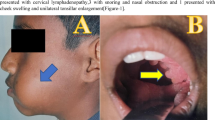Abstract
Background and Objectives
Ear, nose and throat (E.N.T.) malignancies in children are rare and can have different characteristics than those occurring among adults. Early diagnosis and treatment can improve the survival rates. The aim of this study was to determine the incidence of different E.N.T. malignant tumours in children and the way they presented so that they could be diagnosed early and managed efficiently in time. The other object of the study was to highlight the clinical, pathological, diagnostic and therapeutic features of E.N.T. malignancies in children which were of paramount importance in their effective management.
Material and Methods
This hospital-based observational study reports on the incidence of different E.N.T. malignancies in children seen over a period of 5 years in the Department of E.N.T. in a tertiary care medical college hospital. We studied 25 patients in this case series of paediatric E.N.T. malignancies.
Results
E.N.T. malignancies accounted for approximately 20% of all paediatric malignancies. We observed 17 (68%) cases of carcinoma while mesenchymal malignancies were seen in 8 (32%) cases. Mesenchymal tumours included rhabdomyosarcoma, fibrosarcoma, and neuroblastoma etc. The nasopharynx and laryngopharynx were two of the commonest sites. Other less common sites were the parotid gland, nose and paranasal sinuses, tongue, oesophagus and larynx.
Conclusion
The E.N.T. malignancies in children are rare and constitutes 20% of all paediatric malignancies. Carcinoma was found more common (68%) than the sarcoma (32%). The nasopharynx and laryngopharynx were found to be the most common sites. They usually present with features that are common in benign illnesses thereby masking the serious nature of the disease. However, the awareness about these tumours and complete examination and early imaging studies and biopsy in suspected children can secure early diagnosis. Radiation therapy is commonly used either alone or with chemotherapy. Radiotherapy can also be given either before or after surgical excision. The pathological nature of the tumour and the time taken to start definite treatment determines the prognosis.





Similar content being viewed by others
References
Sutow WW (1964) Cancer of head and neck in children. J Am Med Assoc 190:414
Steliarova-Foucher E, Stiller C, Kaatsch P, Berrino F, Coebergh JW, Lacour B et al (1970s) Geographical patterns and time trends of cancer incidence and survival among children and adolescents in Europe since the 1970s (the ACCIS project): an epidemiological study. Lancet 364:2097–2105
US Mortality Data (2006) National Center for Health Statistics. Centers for Disease Control and Prevention, 2009. https://www.cdc.gov/nchs/data/nvsr/nvsr57/nvsr57_14.pdf. Visited on 1 Mar 2020
Barr R, Riberio R, Agarwal B, Masera G, Hesseling P, Magrath I (2006) Pediatric oncology in countries with limited resources. In: Pizzo PA, Poplack DG (eds) Principles and practice of pediatric oncology, 5th edn. Lippincott Williams and Wilkins, Philadelphia, pp 1605–1617
Satyanarayana L, Asthana S, Labani SP (2014) Childhood cancer incidence in India: a review of population-based cancer registries. Ind Pediatr 51:218–220
Arey JB, Nelson WE (eds) (1968) Textbook of pediatrics, 9th edn. Saunders, Philadelphia, p 1437
Ellis RWB, Michell RG (1969) Diseases in infancy and childhood, 6th edn. ELBS and E.S. Livingstone Ltd, Edinburgh, p 360
Abu Bashar MD, Thakur JS (2017) Incidence and pattern of childhood cancers in India: findings from population-based cancer registries. Ind J Med Paediatr Oncol 38(2):240–241
Rush BF, Chambers RG, Ravitch MM (1963) Cancer of head and neck. Surgery 53:270
Jaffe BF, Jaffe N (1973) Head and neck tumours in children. Pediatrics 51(4):731
Bhatia PL, Gupta OP, Samant HC, Mehrotra ML (1977) Juvenile epithelial malignancy of head and neck. J Otolaryngol 6(3):208–214
Sarin R, Thomas PRM (2003) Squamous carcinoma of the larynx and hypopharynx in children: an enigma and a dilemma. Med Pediatr Oncol 40(5):273–275
Snow JD Jr (1975) Carcinoma of nasopharynx in children. Ann Otolo Rhinol Layngol (St Louis) 84(6):817
Dempsey RF, Chelius DC Jr, Pederson WC, Maricevich M et al (2019) Pediatric craniomaxillofacial oncologic reconstruction. Clin Plast Surg 46(2):261–273
Hugo NE, McKinney P, Griffith BH (1973) Management of tumors of the parotid gland. Surg Clin North Am 53(1):105–111
Lee JY, Kim HK (2007) Primary olfactory neuroblastoma originating from the inferior meatus of the nasal cavity. Am J Otolaryngol 28(3):196–200
Cunningham MD, Kung FH (1972) Combined therapy for middle ear rhabdomyosarcoma. Am J Dis Child 124(3):401
Southwick HW, Slaughter DF, Majarakish OD (1959) Malignant diseases of head and neck in childhood. Arch Surg 78:678
Funding
Nil.
Author information
Authors and Affiliations
Corresponding author
Ethics declarations
Conflict of interest
Author declares no conflict of interest.
Ehical Approval
This case series is an observational study, so no ethical approval was required.
Human and Animal Rights
Research does not involve Human Participants and/or Animals.
Informed Consent
Consent was obtained.
Additional information
Publisher's Note
Springer Nature remains neutral with regard to jurisdictional claims in published maps and institutional affiliations.
Rights and permissions
About this article
Cite this article
Bansal, M. Otorhinolaryngology Malignancies in Children: A Case Series. Indian J Otolaryngol Head Neck Surg 72, 443–447 (2020). https://doi.org/10.1007/s12070-020-01881-2
Received:
Accepted:
Published:
Issue Date:
DOI: https://doi.org/10.1007/s12070-020-01881-2




